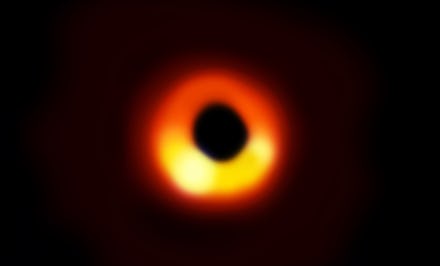This is what it looks like when a black hole 'shreds' a star

Despite how terrifying the thought of being sucked into one may be, NASA still has very little knowledge of how black holes actually work. Given that they're technically invisible, they're difficult to photograph and capturing their activity is even more difficult, despite special instruments designed to do so. Imagine the shock, then, when researchers at The Ohio State University's network of robotic telescopes picked up some of the most detailed data ever of a black hole completely decimating a star.
In fact, this look at the phenomenon, which is referred to as a tidal disruption event (TDE), is the first for NASA's Transiting Exoplanet Survey Satellite, or TESS. It couldn't have been done without the aforementioned telescopes, however, found at Ohio State University. Details of the findings were shared Thursday in The Astrophysical Journal.
Specifically, the telescope fleet, or the ASAS-SN (All-Sky Automated Survey for Supernovae), ended up capturing "one of the brightest TDEs we've seen," said Patrick Vallely, co-author of the study and National Science Foundation Graduate Research Fellow at Ohio State speaking to Science Daily.
"Due to the quick ASAS-SN discovery and the incredible TESS data, we were able to see this TDE much earlier than we've seen others -- it gives us some new insight into how TDEs form."
What is a tidal disruption? Put simply, it's the massive amount of destruction that occurs when a star gets too close to a black hole. Just as the way your body might react and undergo "spaghettification" where your entire body is turned into a noodle-like appendage, the same can happen to a star. That, or it'll simply be absorbed into the black hole. Neither are optimal situations for a human, or a star, as NASA sought to teach in a recent educational video.
"TESS data let us see exactly when this destructive event, named ASASSN-19bt, started to get brighter, which we've never been able to do before," said Thomas Holoien, a Carnegie Fellow at the Carnegie Observatories. The researchers were able to act fast and set up additional observations over the next few days, which should supply them with invaluable data about the energy outbursts they've been seeing that indicated the "star-shredding" phenomenon.
Tidal disruptions are extremely rare events, and it's only by chance (and well-timed monitoring by TESS) that one was actually captured. They can occur about once every 10,000 to 100,000 years when it comes to galaxies the size of ours (the Milky Way). There have only been about 40 discovered throughout human history, so the fact that the event was not only captured, but additional information was gleaned from the event, is a big deal.
During this particular tidal disruption, the temperature dropped around 50% from about 71,500 degrees Fahrenheit to about 35,500 in just a few days, which is the first time a decrease has been seen so early. It also produced some X-ray emissions, which scientists don't actually fully understand just yet.
What of the star that got destroyed? According to astronomers, it was obliterated by a supermassive black hole (read: a very large one) that weighs about 6 million times the mass of the sun and located about 375 million lightyears away in a constellation called Volans. The star was no small fry, in other words. But the size of the black hole doesn't change to accommodate the size of the star it's devouring, as you may think.
The star it did take down, however, may have been close to the size of our own sun, which is chilling: to think such a massive event could one day befall our solar system should a black hole appear too close to the sun? It's absolutely mind-boggling to comprehend the size and amount of mass involved in such an event, and scary too.
But for now, this is a great and useful step forward in the right direction for studying black holes. The more we know and understand, the better prepared humans are to face them – though hopefully it's never something any of us have to in any of our lifetimes.